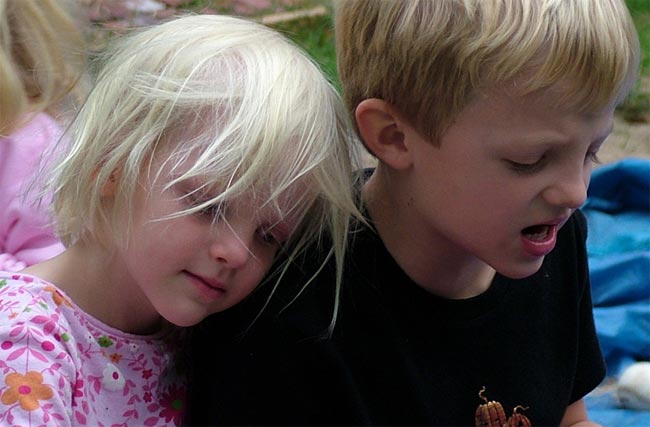Research Reveals Secret Causes of Sibling Spats

Oh the sweet sounds of sisterly and brotherly love. “That’s mine!” “No fair!” “Give it back!” “She’s cheating.”
Family gatherings often turn into chaos when kids erupt into earsplitting spats. Now scientists have found some underlying reasons for sibling fights and ways to bring calm back to the household.
Sibling spats are inevitable. If your daughter wants to watch one television program and her sister wants to watch another, the two interests are incompatible. “It’s a very simple difference. What I want means you don’t get what you want,” said Hildy Ross of the University of Waterloo.
- When fathers say they are less in love in their marriages, their children are closer with siblings.
- Sisters feel closer to their siblings than do brothers, and relationships between brothers and sisters gets closer in later adolescence.
- Rather than encouraging kids to forget past quarrels, it might be better if parents use the conflicts to help children learn conflict resolution skills.
- Children can reach after-the-fact compromises to resolve long-standing conflicts.
But rather than resulting from a tiff over a snatched remote or a condescending comment, sibling rivalry could reflect broader family dynamics.
Family affair
A research team led by Ji-Yeon Kim of Pennsylvania State University interviewed mothers, fathers, and first- and second-born children in 200 white, working- and middle-class families. Kids aged 9 to 17 answered questions such as, “How often do you go to your sister/brother for advice/support?” The scientists asked parents questions about family conflicts and levels of closeness.
Sisters showed closer ties with siblings than brothers did, and for both genders, discord peaked when the first-born was 13 and the second-born about 10 years old.
Sign up for the Live Science daily newsletter now
Get the world’s most fascinating discoveries delivered straight to your inbox.
When mothers reported warm relations with children, the siblings also reported intimacy with a sister or brother.
The researchers also found that as a father’s intimacy with his wife declined, siblings were closer with one another. When a father reported positive feelings about his marriage and wife, sibling intimacy took a dive. Rocky relations between parents could lead siblings to turn to one another for support, wrote Kim and her colleagues in the November/December issue of the journal Child Development.
Give and take
Figuring out ways to defuse heated fights is important since sibling relationships can last a lifetime.
Should parents have kids revisit their squabbles after the fact? To find out, scientists led by Hildy Ross, the University of Waterloo researcher, turned back the clocks for 64 sibling pairs in a separate recent study. They asked the siblings, aged 4 to 12 years old, to choose a past or ongoing conflict and then try to come up with a solution during 10-minute discussions.
Children selected various types of past conflicts, including harmful actions such as hitting; excluding, deceiving or taunting a sibling; damaging the other’s possessions or taking them without permission; and so-called goal interference, where a sibling intruded on another’s activities.
Of the participants, 42 percent compromised to come up with a solution that satisfied both, and 23 percent of sibling pairs came to an agreement that benefited just one. “They are no longer in the heat of the battle. They’re coming back to something after the strong emotions passed, for the most part and able to listen to one another,” Ross said.
“It was interesting to me that in light of the fact that in normal conflicts kids hardly ever compromise with one another that they did manage to reach compromises here in this study,” Ross told LiveScience.
Little disputes
Blame-casting and selfish requests led to no compromise. Instead, focusing on a plan for the future yielded successful resolutions, the researcher suggests
In one failed effort, a 6-year-old sibling said she was still bothered by the fact that her 9-year-old brother had taken her basketball and refused to return it. The older brother started with a plan that only considered his own goal of playing with the basketball. In response, the sister repeated, “But you took my basketball,” adding that she had a witness. She rejected her brother’s plan in the end, and the pair never came to a solution.
In a successful scenario, a 9-year-old girl said she opposed her brother’s request to play with her gerbils since the 5-year-old boy might mishandle them. At first, she offered to let him play with the gerbils for 15 minutes. And to keep her gerbils safe, she negotiated: “OK, when you are by yourself, I have to be with you so you do not hurt the gerbils by accident, like you do not pull off their tail by accident, or something like that or you do not squeeze too hard. You know what I mean?” In the end, the siblings agreed to a plan. Ding, ding. Gerbil conflict resolved.
- Top 10 Mysteries of the Mind
- Human Nature: What We Learned in 2006
- Kids are Depressing, Study of Parents Finds
- Emotional Wiring Different in Men and Women
- All About the Mind
Jeanna Bryner is managing editor of Scientific American. Previously she was editor in chief of Live Science and, prior to that, an editor at Scholastic's Science World magazine. Bryner has an English degree from Salisbury University, a master's degree in biogeochemistry and environmental sciences from the University of Maryland and a graduate science journalism degree from New York University. She has worked as a biologist in Florida, where she monitored wetlands and did field surveys for endangered species, including the gorgeous Florida Scrub Jay. She also received an ocean sciences journalism fellowship from the Woods Hole Oceanographic Institution. She is a firm believer that science is for everyone and that just about everything can be viewed through the lens of science.









